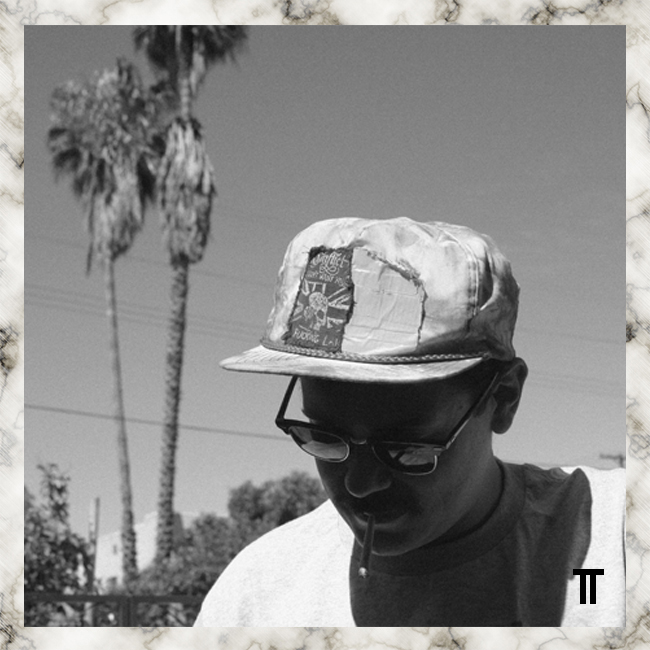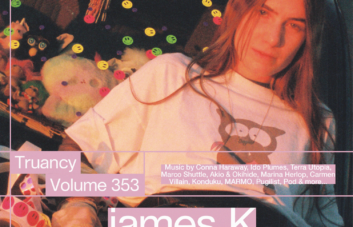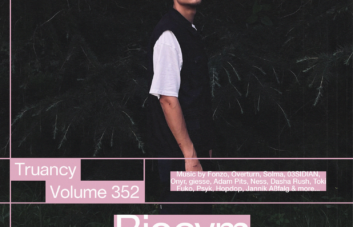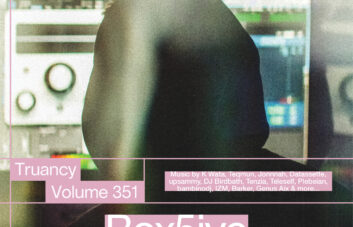Ged Gengras’ name has cropped up a lot lately. He’s been in bands such as Robedoor and Pocahaunted, he’s released on Truants-favourite Opal Tapes as Personable and then there’s the music he releases under M. Geddes Gengras. In typical fashion, Ged has had a busy 2014 as earlier in the year he released a beautiful ambient record Ishi on Matthewdavid’s Leaving Records and a second instalment of his Collected Works series is forthcoming on Umor Rex. Then there is Duppy Gun Productions, a label he started with frequent collaborator Sun Araw, which has a collective release Multiply out just this week via Stones Throw. Hugely pervasive, this all exemplifies how varied and prolific he is in his productions, and we’re incredibly excited that he’s agreed to do a mix for us under the guise DJ Chardi. With Duppy Gun, the pair have created some of the most weird and warped dancehall in recent memory and Ged kindly answered some of our questions about it and his other projects.
You’ve had a pretty busy year so far having released your record ‘Ishi’ a few months back and you’ve got the second Collected Works release on Umor Rex. Not to mention the Duppy Gun Productions compilation that you’ve put together along with Sun Araw all coming up. How did the compilation come about? It seems like it was a pretty big project to take on. “Multiply has been simmering since January 2011 when Cameron and I first went to Jamaica to record what became Icon: Give Thank with The Congos under the auspices of RVNG Intl. Living under the rasta umbrella in Portmore, we were brought into this amazing community of artists. People were always hanging in the studio that we basically lived in, and it was inevitable that we started to expand the scope of our trip. The cuts (“Multiply”, “Spy”, “Earth”, “Up Wit U Baby”) that made up the first two Duppy 12’s were tracked on that trip. After we self released the first single, and with only one more left in the clip, we approached Stones Throw about working with them and financing another recording trip to the island. They were excited about the project and so we started making the riddims and hitting up some of our favourite LA producers to do the same. It was around early 2013 that we returned and spent two weeks exploring the island and recording new tracks. Multiply is the document of those trips and also the culmination of the first phase of Duppy Gun.”
It’s great that you got in a bunch of lesser-known dancehall vocalists in for the record. What was your process for discovering the vocalists? Were you already familiar with some of them? “The Duppy network has its hub in The Congos. Early One and Lukan I are both residents of Forum, a small shanty village built in the shadow of a condemned hotel. It’s very close to Congos HQ where Roy used to fish. Day One was always hanging around the HQ compound and I Jahbar is Ashanti Roy’s nephew. From there the circle spread out and these artists started bringing their friends and proteges around. They would introduce us as producers everywhere we went, which meant that we were getting pitched songs left and right on the street, at bars and even whilst playing dominos. It was a constant stream of music. As we became more comfortable with the island, we ventured out further and started recording people where they lived.”
One of the most interesting parts of the release is the promise of a ‘Visual Version Excursion’ by film maker Tony Lowe. Could you tell us a little more about this? “I met Tony Lowe in 2010 at a show my old band played in New York. I didn’t see him again until we were both in Jamaica. He had come along to document the Congo’s album and make what would become Icon Eye. What started as a documentary quickly expanded in scope to something that was more of a ‘visual dub’ of the process of recording and living that album. You know when you meet someone and right away you feel like ‘this guy GETS IT’? A freakish devotion to the cause and that same sense of life transformation that Cameron and I felt on the heels of “Icon”. It was obvious from the get-go that Tony would remain a philosophical & practical partner in this excursion. His contribution has been huge and on more fronts than is immediately presented, but he is an equal member of the team on all levels.
For this trip, since all the music was done and we were there to voice tracks only, we decided to skip renting a studio and bring a minimal laptop-based recording rig on the trip instead. Mbox, Shure SM7b, an XLR cable & two pairs of headphones. We bought a 50′ extension cord on our first day there. This ended up being one of the best decisions we made because, in addition to freeing up more funds to pay the vocalists upfront, we were never tied to a schedule and could set up anywhere we could find an outlet. Another benefit was that instead of shooting the inside of a vocal booth for two weeks, Tony was filming our artists recording in bars, derelict houses, by the beach, in the jungle, in a half-built home, on a farm or on the balcony of a rented estate in the mountains. It was just an endless parade of beautiful locations. Videos for some of the songs were culled from this footage, but the meat of the archive was relatively untouched. About a year after the trip, Cameron and Tony buried themselves in a studio in Bushwick for a week, enlisting deep crew Julian Paradise for some analog after burns, and cut together ‘Visual Version Excursion’. While I won’t try and speak to their ideas, I will say that what was so successful about Icon Eye and remains in ‘VVE’, is that there is a deep truth revealed in the mundane, the psychedelic and the borderline between the two. The picture that is painted is so true to the experience that I had there, in part because these experiences usually have no narrative, don’t make sense and are only able to be comprehended in the moment as a stream of random imagery and themes. We used dubs/versions of the tracks from the album along with unreleased riddims, so along with the video there is around 1.5 hours of music in there that isn’t on the LP. So in that way the film is every bit the equal of the record; a true companion-piece, and it turns a laser pointer on for those having trouble getting what this is all about.”
Has dancehall and Prince Jammy’s music been a lifelong passion? Can you tell us about your initial introduction and experience to this music and why you think it attracted you so much? “Dancehall has been something I’ve been obsessing over on and off for years, though it came into focus pretty hard during and directly after my first trip to Jamaica. I did however listen to a lot of college radio as a teenager and a lot of these stations would have reggae/dancehall/soca shows. The dancehall really grabbed me though; it seemed so foreign and oblique to me at that point and combined with the Jamaican DJ style, it really felt like just one of the most extreme, drastic forms of music I had ever encountered. Real minimalism, where every song is basically a loop of 4-6 elements and then there can be untold different songs sung over that loop. It’s endless.”
How long have you been collecting Jammy’s music? It seems like you’ve built up a pretty formidable collection of it. “I guess I started collecting dancehall stuff on that first trip to Jamaica. I had a few pieces I had picked up here and there, but on a trip to a record dealer’s place I ended up spending hours digging through a huge pile of 80s & 90s dancehall 45’s and that was probably the spark. Lots of cuts on Shocking Vibes, Xterminator, Jammy’s and Digital B. I never decided to collect Jammy’s stuff specifically but it’s one of those labels that makes a record worth checking out most of the time.”
Is Jamaica somewhere you spend a lot of time now? Can we expect similar kind of music from you in the future? “There is always another trip on the horizon, though at the moment it’s unclear when that one is. However the torch has been lit and must continue to burn. As I said, this is the culmination of the first phase of this whole thing, so now that it’s on its way into the world we can begin to formulate the next one. You can definitely expect to see more from Duppy Gun in 2015.”
How does this kind of music influence you, if at all, in the music you create as M Geddes Gengras, Personable etcetera? “Extended studio technique, creative solutions to sonic problems and creating new sounds with old gear. All this stuff really appeals to me. Dub music is all about a creative use of limited tools which is more than a skill; it’s my ethos in creating and recording music. Beyond that there is a spiritual involvement and inspiration that links, making music as divine expression and line of communication with that world. Though the sounds may be different, we are creating for the same reasons.”
Building on that, how does your approach to making music differ from when you’re producing with and for other people like with Duppy Gun than when you’re making your own music? Is modular gear still as important for you? “I try to approach every project from a fresh perspective and use the tools that are most natural to me and to what I’m trying to do, so it definitely shifts around a fair amount from project to project. I don’t think I’ve done anything in the past five or so years that wasn’t at least touched by the modular. That could just be because it’s the piece of gear I dump the most money into, but I am really comfortable with that set of tools and that style of workflow. This is especially the case when I’m working with somewhat more generic sounding elements such as Ableton and drum machines. Using the synth to process/modify/augment those sounds outside of a computer is a big part of what I do.
The Duppy process formed in a weird way. In large part it’s based on how Cameron and I usually work, but we make all of our riddims live, mixed in real time and recorded to a single stereo track. Generally I handle the rhythmic elements and mixing while Cameron covers the melodic content. Those lines can blur from time to time however. The rhythms are made with a hybrid of drum machines and modular gear and everything is routed so that any sound can be sent out to four different effect chains in real time. We work up a frame, jam on it, talk about it, record it, and edit it after the fact. Mixing it live means that we are stuck with a lot of decisions, but it also provides a real human feel, with proportions constantly shifting and everything moving around together in space and time.”
Moving on to your other records, the upcoming Collected Works release is a bunch of unreleased stuff you made from 2011-2012. Did you make these with the intention of them being on a record like this or did the idea come long after they’d been recorded? “The record was conceived in late 2011 as an album. Some of the material had been made prior to that but the idea was always to release it as it comes out now, I was just unable to find a home for it at the time. I had been integrating modular elements into my music for a while, but this was my first attempt at creating a whole world out of them. Using a small system of modules and an old tape echo, I was really trying to explore the limits of my technique and the instrument itself while defining a new form of interaction with it.”
Your other record this year “Ishi” is a beautiful release and, from what we’ve gathered, an incredibly personal one for you. What kind of mindset were you in when you made the album? Any particular backstory that may be attached with the record? “I was trying to create something that was calm. It was a reaction to loss and mental illness and my initial idea was to make music that was small and gentle, but to properly honour those losses meant respecting the chaos as well. The original tracks were processed over and over again and the spread of digital glitch, analog, tape echos and pitch shifting were used to emulate that aspect of it, such as the creeping edges that spill out around every note. These simple melodies became cathedrals of sound and I could hear the buzz of real life inhabiting each corner.”
You’ve recorded the mix you’ve done for us under DJ Chardi. Who or what is DJ Chardi? “DJ Chardi is me toting around a big box of $.50 dancehall 45’s.”
What were you trying to convey with this mix? “This mix is sourced from my collection of Jammy’s dubplates. Dubplates were records (often acetates) pressed for a specific party or sound and often played once or twice and filed away. These often consisted of popular songs of the time which DJs then toasted over, chatting up the sound they are representing. These also included covers, exclusive edits and anything that the selector could use to pump up the crowd and talk down any sound that dared step to them. These were throwaway tracks recorded in the time it takes to listen to them, mixed for maximum dance floor impact and usually cutting out somewhere in the second or third verse with a brutal fade. These records represent some of the weirdest and rawest dancehall and roots music I’ve ever heard, presented in all their thrashed and noisy glory.”
You mentioned the throwaway and for-purpose a lot of the music in the mix is. Is that what drew you to a lot of this music? “That’s a part of it. I love how rough the productions are, and the idea that some of these tracks might not exist anywhere else. The trashed labels and generic sleeves make each one a mystery to be uncovered. In general these are weirder, the crooners croon more outrageously, the lyrics are goofier, the backup vocalists are laughing, the mix is totally wrong. Even the format of these acetates means that after 50-100 plays at most, they will be unlistenable. It’s like a ‘disintegration loop’ you can dance to.”
We’re in a place now where everything is cataloged and archived and to an extent the idea that tracks can be played a couple of times and be forgotten about is disappearing. Do you think we could benefit from taking a step back from that? “I think everyone could spend more time appreciating art instead of seeing/hearing/collecting/archiving it, for sure, but I don’t have a problem with those limits being explored and people logging their research. Finding great-but-lost music is a public service. I do worry that accessibility makes people treat things less preciously, but for someone getting into music for the first time, trying to find what they like, this is the best possible time to do it.”
You’ve covered so many different bases recently that it’d be impossible for us to predict, so what next for you? “More bases, more Duppy Gun, more records, new Personable LP on Peak Oil in January and an MGG 2x LP at some point after that. Hopefully a lot of free time to play in the studio and figure out what’s next.”




